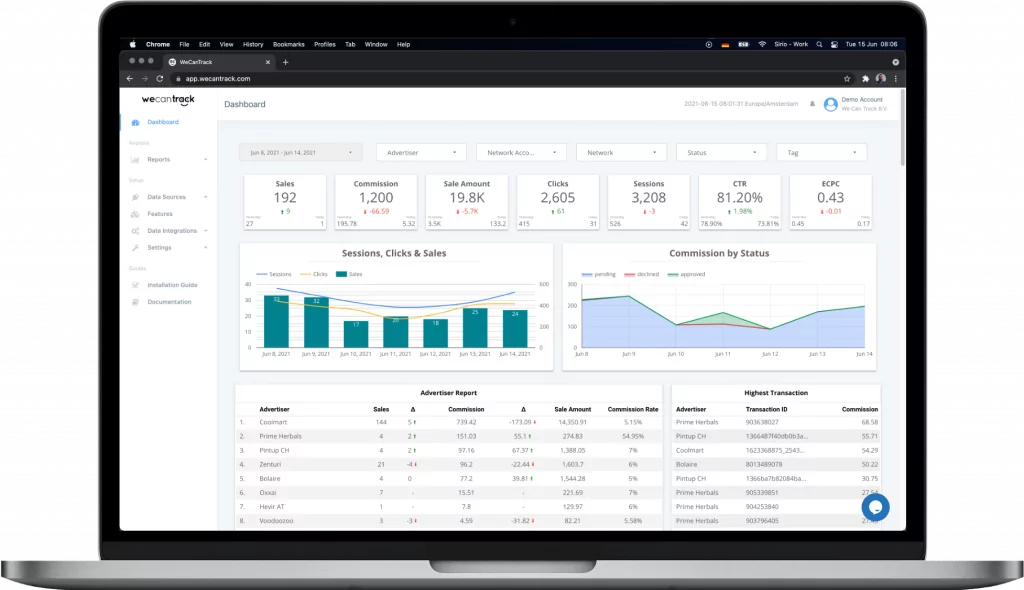Email marketing remains one of the all-time stars of digital marketing success stories. The global email marketing market was $7.5 billion in 2020 and is expected to reach $17.9 billion by 2027, undergoing a CAGR (Compound Annual Growth Rate) of 13.3%.
This alarming growth also signals to affiliate marketers that email is a goldmine that lies unexploited — and that could dramatically improve conversions and ROI.
This article will examine some key affiliate email marketing statistics and explain why they could be your secret weapon for driving revenue and improving your campaigns.
Table of Contents
Key Affiliate Email Marketing Statistics
- About 22.8% of affiliate marketers employ email marketing as their leading traffic source.1
- Affiliate marketers who employ email marketing get 66.4% more conversions than those who do not.1
- More experienced affiliate marketers are now using email marketing than newbies by 47.8%.1
Why Email Marketing Remains A Leading Traffic Source
Around 22.8 % of affiliate marketers choose email marketing to attract campaign traffic. This indicates that almost a quarter of affiliate marketers value email above platforms due to its effectiveness in directly reaching audiences, encouraging interaction, and boosting conversions.
By opting for email as their approach, these marketers harness its power to provide tailored content, establish trust, and maintain ongoing communication, with potential clients establishing it as a fundamental aspect of their affiliate marketing achievements.
Demographic Affiliate Email Marketing Statistics
- According to the report released by eMarketer in 2023, spending on affiliate, email, and comparison site marketing and advertising in France was 970 million euros, up from 905 million in 2022.2
- Affiliate and email marketing are among the most significant online income sources, accounting for more than 16% of all ecommerce orders in the USA and Canada.3
Email Marketing Soares In The US
Affiliate marketing and email campaigns account for more than 16 percent of sales in the United States and Canadian markets, clearly indicating their significant role as key revenue-generating channels.
Email marketing fosters customer connections by sending personalized and timely messages to boost engagement and drive sales forward effectively. Meanwhile, affiliates rely on trusted networks to endorse products or services and leverage their credibility and targeted audiences. When these two strategies are merged, they create a synergy. Email enhances affiliate promotions, while affiliate networks deliver top-notch leads for email campaigns.
Their success as sales leaders stems from their knack for delivering results that can be measured and tied to return on investment (ROI).
Through interactions with customers across platforms and building trust over time, affiliate marketing and email campaigns enhance the online shopping experience by attracting visitors and converting them into actual sales.

Affiliate Email Marketing Success Statistics
- Email marketing provides the highest ROI for affiliate marketers, followed by SEO and content marketing.4
- According to an eMarketer estimate, affiliate marketing generates 15 percent of total digital media revenue, equal to email marketing and higher than advertising display.5
- Email campaigns are effective among the tactics for promoting affiliate links, according to 48% of affiliate marketers.5
- 78.3% of marketers drive traffic from their websites using SEO, 35.5% use organic social media marketing, and 22.8% use email marketing.6
- Email marketing and PPC (Pay-Per-Click) are also significant, used by 42% and 34% of marketers.6
- Email marketing’s traffic acquisition is around 22.8%.6
Why Email Campaigns Work
Around 48% of affiliate marketers acknowledge that email campaigns are among the strategies for promoting affiliate links. Email’s effectiveness lies in its capability to send tailored messages to audiences directly, build trust, and entice clicks on affiliate links.
Email marketing allows affiliates to connect with their audience through segmentation and communication. This makes it a crucial tool for increasing conversions and maximizing revenue in affiliate campaigns.
The key lesson from AppSumo’s achievements is the effectiveness of humor in affiliate email marketing campaigns. The clever use of relatable language can help build trust with readers and increase their openness to marketing messages.
Adopting a tone in your website content can establish a consistent brand identity that enhances visibility and drives more conversions.

Affiliate Email Marketing Trends
Here are some of the most important trends in affiliate email marketing marketers can look out for in 2025.
Focus on First-Party Data and Privacy
Due to data privacy laws being enforced and third-party cookies being removed, affiliates focus on first-party data to ensure compliance and trust. Thus, affiliates can gain reliable and compliant data sets by asking users to provide their contact information, such as an email address, when they sign up for newsletters.
This strategy strengthens the bond with the audience as people are more willing to provide their information to the brands they trust. Therefore, affiliates can use this data to create interesting content that is relevant to their audience and lists. It is time, therefore, to comply not with surprise legal requirements email lists.
Building An Email List
An email list is useful because it enables affiliates to interact with their audience even when social media algorithms hide their posts or platforms are down. Thus, if affiliates provide valuable content regularly, they can interact with subscribers and include affiliate promotions in their newsletters.
Some useful and interesting content ideas may include calls to action, such as free downloads, business tips, entertaining stories, and exclusive offers. Therefore, when using promotional emails to drive conversions, it is important to ensure that they include informative and engaging content to prevent spamming subscribers and losing their trust.
Featuring Affiliate Content Prominently
There is no more hiding in the shadows regarding affiliate marketing – brands flaunt their affiliate content. What was once the part and heart of the element of it? Overall, it is an affiliate-driven marketing SaaS promotions strategy. This strategy was that once the was a case often afterthought, for brands to that the background to partner create with affiliate influencers content such as product reviews, how-to videos, lists of products, and even live videos.
For instance, live-streaming ecommerce giants like Amazon have taken this concept a step further by integrating affiliate-generated content such as live product demonstrations and gift ideation content. Providing incentives such as higher commissions for developing unique content motivates the affiliates to create quality and useful content that would, in turn, boost the brand’s authority.
Social Proof and Community Insights
Other users are now playing a major role in consumers’ decision-making process, which is why social proof is effective in affiliate marketing. Implementing customer reviews and feedback, particularly community reviews, within the context of an affiliate program helps establish trust and converts visitors into buyers. Therefore, screenshots of the reviews can be displayed in the affiliate’s marketing materials to showcase what makes a product or service valuable.
With the help of affiliate tracking tools, marketers can track their performance and devise the best way to structure their commissions to enhance performance and the development of the partnership.

Moving Forward
Affiliate email marketing has remained relevant and has become essential to many digital marketing plans. This is because email marketing has been proven to deliver some of the highest ROIs, and affiliate marketers can make much more money by utilizing this channel, which proves that email is still one of the most effective methods to reach the audience and turn them into customers.
Therefore, it is the latest important trend that marketers, as affiliates, must keep marketing on channels. Updating this is because focusing on first-party data collection will also help ensure that only the relevant company people remain compliant. They also list gains to ensure the trust of the audiences the customers engage with while ensuring the quality of content being sent to them regularly.
Affiliates who have embraced these strategies and learned how to navigate the ever-changing world of consumers will benefit most from them. Implementing these insights and trends into your strategy will allow you to take your affiliate email marketing to the next level and create a stable and profitable income stream.
Frequently Asked Questions
How do I become an email affiliate marketer?
- Deliver information to your audience.
Please refrain from sending intrusive messages. - Choose affiliate schemes that match the preferences of your audience.
- Utilize personalization as a way to foster connections.
- Ensure to include concise and persuasive prompts for action in your content.
- Make sure to abide by the guidelines of every affiliate program you join.
- When crafting your promotions, try to incorporate stories or insights to connect with your audience on a relatable level.
Can I put affiliate links in email?
Yes, but make sure to review the terms and conditions of each program to understand what is acceptable; in general, most programs permit the use of affiliate links in emails.
How much money do I need to start email marketing?
The cost of an email campaign isn’t one size fits all or set at a fixed amount per email sent out to subscribers or customers in your list, according to our conversation on the topic of email marketing expenses; it can vary from $10 to, over $10k monthly based on whether you opt for freelance assistance or engage a professional email marketing firm for your campaigns.
How to build a mailing list?
- Provide enticing incentives for leads.
- Employ exit intent pop-ups.
- Enhance the registration forms in places with a lot of visitors.
- Encourage the use of premium content offerings.
- Organize competitions and promotions to keep things interesting!
- Make use of advertisements on social media platforms.
- Turn the participants of the seminar into subscribers.
- Establish a program for referrals from subscribers.
How do email marketers get paid?
Suppose you enjoy crafting email newsletters and often find joy in reading them. In that case, there’s a good chance that recommending your favorite newsletters to your audience can be a simple yet effective way to generate income through email marketing using the Kits Paid Recommendations platform.




